|
Using Links
|
|
Tools
|
Different chainmail makers like different kinds of pliers. Some use needlenose, but I've never liked them. I prefer to use 7" Linesman Pliers, although some folks will find that 6" or 8" are more appropriate for their hand size. You will need two pair of identical pliers to create chainmail properly. This is one of my favorite pairs, made by a company called Jet. |

|
|
|
Important Technique
|
The main reason that I prefer linesman's pliers is because of the way the wide jaws will completely cover the width of most links. This allows you to apply very even pressure on the links as you manipulate them. Even pressure is vital in keeping links flat. Lineman's pliers also have flat tips, most needlenose pliers have a rough surface over the entire length of the jaw which can damage the finish of links. IMPORTANT! IMPORTANT! IMPORTANT! - The entire process of making chainmail in this manner is very stressful to your hands. Please do not attempt any of the following techniques if you concerned in any way about repetitive stress injuries. This site takes no responsibility for injuries that may be incurred by following these instructions! |
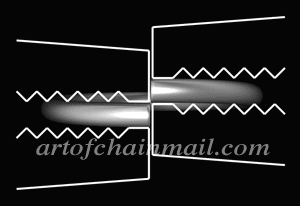
|
|
|
Bending Jump Links Open
|
|
Step 1
|
Before you begin working on any patterns it is a good idea to open a quantity of links. Each pattern on this site will list the proper ratio of closed to opened links for that pattern. Place the jaws of your two pliers on the link to be opened, with each plier covering as close to 50% of the link as possible. Make sure that the break in the link is facing up. Twist the right plier away from your body and at the same time twist the left plier towards your body. It is vital to apply even pressure with both pairs of pliers when using these techniques. |
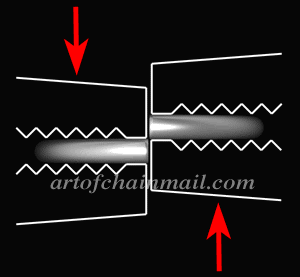
|
|
|
Step 2
|
Open the link only as far as necessary to easily pass through other links. It's much easier to close links that aren't over-opened. |
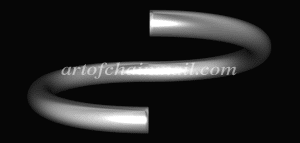
|
|
|
Bending Jump Links Closed
|
|
Step 1
|
Before you begin working on any patterns it is a good idea to close a quantity of links. Each pattern on this site will list appropriate portions of links to open and close for that pattern. Place the jaws of your two pliers on the jump link to be closed, with each plier covering as close to 50% of the link as possible. Make sure that the break in the link is facing up. Twist the right plier towards your body and at the same time twist the left plier away from your body. Again it is vital to apply even pressure with both pairs of pliers. |
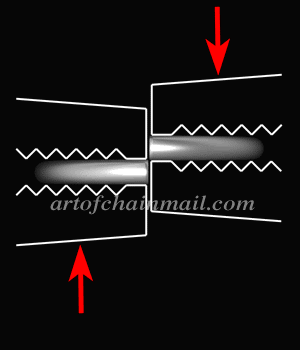
|
|
|
Step 2
|
The link should be absolutely as flat as possible when closed. |
|
|
|
|
Step 3
|
If you are making your links out of a material that is specifically springy, then it might be necessary to slightly over-twist the link, so that when you release the pressure it will spring back to perfect alignment. |
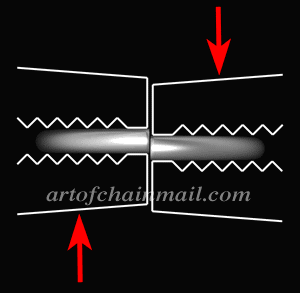
|
|
|
Bending Open Links Closed
|
|
Step 1
|
Closing open links is more difficult than the previous steps, as it is always done when adding a link to other links. Place the jaws of your two pliers on the jump link to be closed, with each plier covering as close to 50% of the link as possible. Make sure that the break in the link is facing up. Twist the right plier towards your body and at the same time twist the left plier away from your body. In some cases it will be impossible to get an even grip on both sides of a link. It's important to get the best grip possible and twist the link with perfectly smooth and even pressure. Don't worry if it takes awhile to develop a good technique for closing links, it probably took me 10 years to start twisting my links consistently and I still ruin 1% of the open links that I close. Be careful when your hands are tired and you don't have a good, even grip on a link that you're trying to close. If your pliers slip it can be very painful, I've bruised myself several times trying complicated bends when I was too tired, I've even chipped a tooth from the force of pliers that slipped. |

|
|
|
Step 2
|
Again, the link should be absolutely as flat as possible when closed. Improperly closed links will be "Saddle-shaped". |
|
| |
|
Misshapen Links
|
|
Step 1
|
Despite your best efforts with closing links properly you are bound to have a few that just don't come out right. I check every link I close to make sure that it is as round as possible. When I find a misshapen link I try and fix it by applying pressure with the tip of the pliers, as in the diagram below. This works to straighten the link 7 out of every 8 attempts. It will take time to learn the correct method, so don't get discouraged if you ruin quite a few links in mastering this technique. |
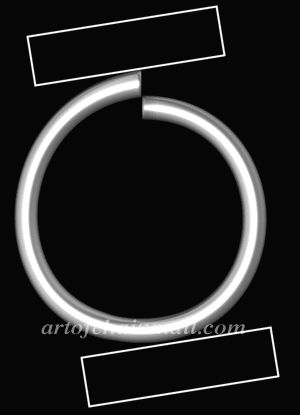
|
|
|
Step 2
|
Try and keep your links as close to perfect circles as possible. |
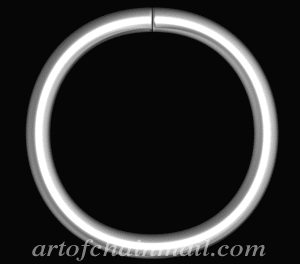
|
|
|
Final Step
|
Continue on to "Pattern Symbology" to learn the final information that you need to start using the patterns on this website. |

